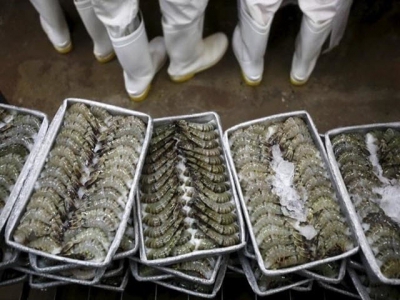Seafood exports to China continues to fall amidst trade spat

Vietnam’s seafood exports to China fell 5 percent in Q1 2019 as a result of the escalating U.S.-China trade war.
Shrimps are arranged on ice before being frozen in a factory in Vietnam's southern province of Hau Giang. Photo by Reuters/Kham
According to the Vietnam Association of Seafood Exporters and Producers (VASEP), Vietnam’s seafood export value to China fell 5 percent year-on-year in 2018 to $1.2 billion, and dropped another 5 percent year-on-year in the first quarter to $239 million.
This is a result of China tightening border trade, as well as the U.S.-China trade spat disrupting the market, affecting demand, and causing the Chinese yuan to depreciate, it said.
As of Tuesday, China's central bank lowered its official yuan midpoint to 6.84 per dollar, the weakest level since December last year, as the latest round of trade talks between the world’s two biggest economies failed to produce a deal and both nations imposed new tariffs on each other’s goods.
Although the dong had been depreciating against the dollar, having falling to a historical low last week, China’s currency has been falling even harder against the greenback, causing Vietnam’s exports to China to become more expensive, the association said.
VASEP predicted that because Chinese importers now tend to choose Indian shrimp over Vietnamese shrimp, exports are likely to decrease or remain at the same level as 2018.
Currently, China is one of Vietnam’s most important seafood markets, accounting for 11 percent of Vietnam’s total seafood exports in the first quarter of 2019, according to the General Statistics Office (GSO).
According to VASEP, China’s proportion of Vietnam’s total seafood exports has been declining, having accounted for 15 percent in 2017 and 14 percent in 2018.
Vietnam’s two biggest seafood buyers this quarter are Japan, which made up 17.1 percent, and the U.S., at 15.8 percent. Vietnam exported $1.79 billion worth of seafood in the first three months, up 1.6 percent year-on-year.
As of May, there were more than 150 Vietnamese enterprises exporting seafood to China, of which 45 export Pangasius fish and 50 export shrimp, while the remaining export other varieties of seafood.
Có thể bạn quan tâm
 Getting aquaculture right: how conservation science can help
Getting aquaculture right: how conservation science can help Science demonstrates that aquaculture is a resource-efficient means of food production and limits to wild fisheries production mean that aquaculture
 CPTPP creates opportunity for pangasius exports to Japan
CPTPP creates opportunity for pangasius exports to Japan Japan has entered the 10 largestpangasiusexport markets of Vietnam, with benefits from CPTPP, this market becomes a potential market of Vietnam’s fishery
 US lifts anti-dumping tariffs from Vietnamese shrimp
US lifts anti-dumping tariffs from Vietnamese shrimp The US is one of Vietnam’s leading shrimp markets, and has a great influence on other markets in terms of price and purchasing decisions.